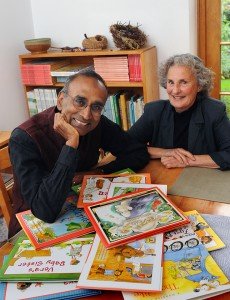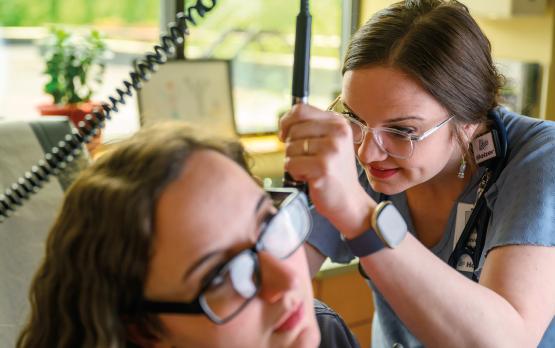
Molecular biologist Venkatraman Ramakrishnan, OHIO’s only Nobel Prize winner, answered other questions about science and his role in it via e-mail. —Editor Peter Szatmary

Nobel Prize-winning molecular biologist Venkatraman Ramakrishnan, PHD ’76, and his wife, Vera Kapka Rosenberry, BFA ’74, a children’s author/illustrator, pose with some of her many books in their home in Cambridge, England. They’ve been married since 1975. Photo by Brendan Kelly.
You stress the importance of a) the funding of science; b) the culture of how science is done; and c) the philosophy of why science is undertaken. Unpack those touchstones a bit.
a) Modern science needs stable funding. Many important investigations take years, if not decades, and involve expensive investment in both people and equipment. Training someone to become a productive scientist often takes a decade. Such an enterprise can only succeed if there is broad-based support for science from government that is not subject to political whims or temporary economic problems. Cutting science funding during difficult times is very wasteful because young people leave the field, and then when things improve you have to spend a lot of extra money training new scientists. Society also needs to realize that in the long term, the big new applications that transform society come unexpectedly from the study of basic fundamental problems that don’t seem to have any obvious applications.
b) The vast majority of science is often doing the next obvious or feasible experiment. When I did a sabbatical at MRC Laboratory of Molecular Biology (where I returned to work in 1999), I was struck by how everyone was working on something really important, even if very challenging. People would constantly ask their colleagues, “Why are you doing this?” This forces people to try to tackle the really important questions in a field. Creating this sort of culture is difficult but essential.
c) Science is part of human culture. We do it because we want to know about the world. Not surprisingly, the more we know about the world, the better we are at inventing things that are useful. So the usefulness of science is simply a natural consequence of a better understanding of nature. It would be a mistake to focus all our efforts on generating immediate practical applications because we need the fundamental breakthroughs to create the completely unpredictable and transforming applications of the future.
Your work experiences straddle higher education (for four years) and national laboratories (the bulk). Do you have a preference? Said another way, what are some satisfactions and challenges of both setups?
They both have advantages. Universities have a constant influx of new students who bring energy and freshness to the enterprise, making it a dynamic place. However, funding is generally short-term and not secure. National labs allow you to focus on long-term research without distractions and other duties such as teaching. The institution where I work combines the advantages of both because we have students and postdocs yet have a stable core of staff.
You give distinguished lectures around the world, from The Johns Hopkins University in Baltimore to the Max Planck Institute in Berlin. What is your message? And to what degree has it changed?
I am not sure it has changed a lot, except that sometimes I have a bigger turnout because of the “Nobel” branding. Mostly I don’t have a “message”— except to tell people about our latest research! Sometimes I will give public lectures, but these, too, are mostly informative rather than with a “message” in the sense of preaching. I have given a few talks about science as a rational enterprise and argued against superstition and irrational beliefs such as astrology and homeopathy.
Governments of many developed and developing countries urge the pursuit of science, technology, engineering, and mathematics—the STEM fields—especially among the next generation. What’s your take on this imperative?
As the world becomes more technologically advanced, it is going to be essential to have a sufficient number of people trained in both using and advancing science and technology. It is also important for the general public to have a basic education in science so they understand at least the basis of all the various issues and decisions that affect them.
I have a sense that you like to write, that writing is important to you. True?
I mostly write scientific papers and reports. I would like to write more generally.
Summarize your contributions to the study of the ribosome since you went on the hunt in the mid-1990s and what you hope to achieve next.
To understand the details of how the ribosome works, it was necessary to see exactly what it looked like, i.e., how those hundreds of thousands of atoms were arranged and connected and how that structure would allow it to function. It is a bit like understanding how a car works— you’d have to look under the hood and chassis to see how things are connected to figure it out. Our contribution was to help determine the atomic structure of the ribosome: analyzing data from x-rays hitting crystals of ribosomes. This provided insights into how it recognized the genetic code and many other aspects of ribosome function. We also discovered precisely how many antibiotics bind to bacterial ribosomes. These compounds bind to pockets in bacterial ribosomes and prevent them from working. Because these binding pockets are slightly different in human ribosomes, they are able to be specific for bacteria. There are many other “antibiotics” that are not so useful because they bind equally to both our and bacterial ribosomes.
We now have much more powerful tools for studying ribosomes—there have been great advances in genetics and in biochemical tools including the ability to study single molecules. A major advance is that we can now obtain detailed structures of the ribosome by electron microscopy. So the arduous job of crystallizing them and solving the structure by x-ray crystallography is no longer essential. So we can do far more detailed and sophisticated experiments.
Finally, the work is important because it sheds light on the origin of life as it exists today. The structures showed that the important parts of the ribosome are made of RNA, solving an old paradox: If the ribosome makes proteins and is itself made of both protein and RNA, where did it come from? The structures support the idea (dating to Francis Crick in the 1960s) that an ancient ribosome may have consisted entirely of RNA and that proteins came much later. In fact, we believe that RNA came before both DNA and protein, so in that sense it is a throwback to a very early form of life.
I am now interested in understanding how ribosomes from higher organisms work, and especially how they are regulated and how viruses can hijack them to make their own proteins.




